Yellow orchids: description, types and care
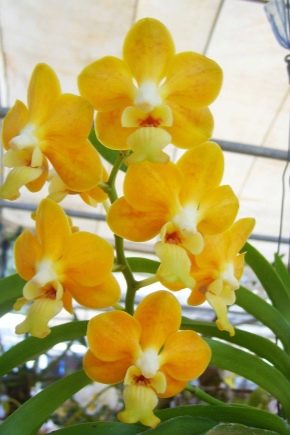
Lovers of indoor plants very often acquire and grow at home a beautiful flower that has a number of shades and up to hundreds of species. This article will focus on the orchid.
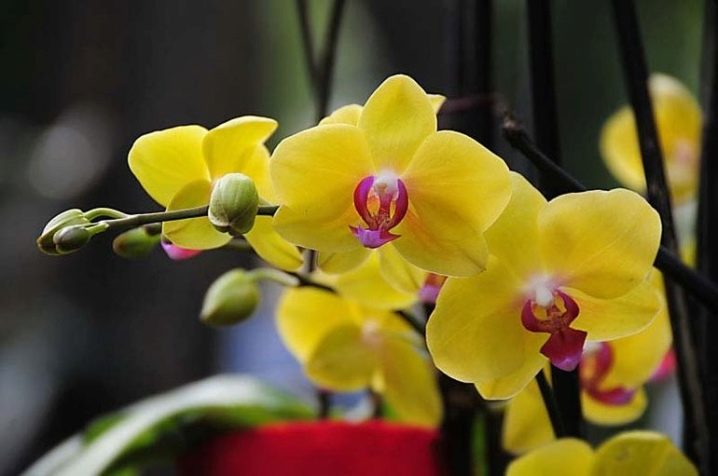
Peculiarities
A yellow moth-like orchid called Phalaenopsis was brought to Russia from Asia in the 17th century. The main feature of this plant is its unpretentiousness in care, as well as a long flowering period - it can be six months. Flowers have different shades and are speckled or move from one gamut to another. An adult indoor orchid rises up to 50 cm in height, and the smell of a flower resembles a honey scent. The shape of its leaves is similar to a cylinder - this circumstance characterizes the phalaenopsis as a plant that does not really need bright lighting.
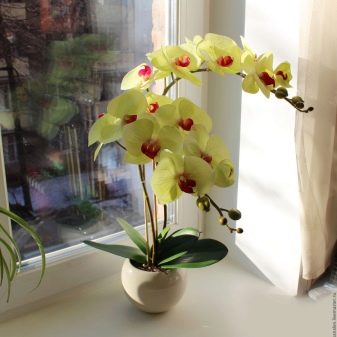
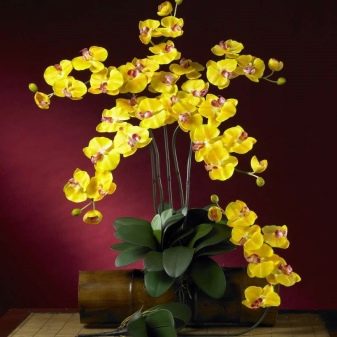
Varieties
Breeders have managed to breed various types and varieties of flowers, intended for growth and development in the home environment. The range of colors is so diverse that sometimes the species of plants is amazing. There are white and cream, there are also burgundy and black orchids. The most popular of them is considered to be yellow phalaenopsis. It can be soft and pale, as well as bright and rich in contrast.
There are a large number of names for orchids with yellow flowers. Among them, the most famous are Meraldy Breckenbridge, Yellow Butterflies, Solid Gold and a number of other names. In these varieties, the lower petal of the flower is painted in a white tone with a purple tint. Part of the perianth sometimes has a yellow background with red spots along the edges or is marked with specks.
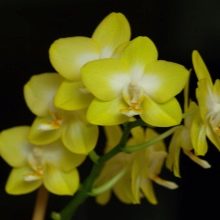
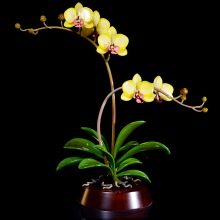
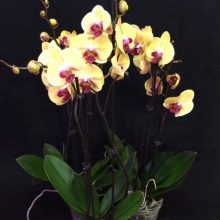
Orchids with yellow flowers differ in the size of the trunk, peduncle and the buds themselves. Both large specimens and varieties of small plants have been bred. Phalaenopsis lives and blooms up to 7 years. There are many orchids and their hybrids grown by domestic breeders. Consider the most colorful of the varieties of this amazing plant.
- The leading place in sales in flower shops is occupied by an orchid called "Yellow Pearl"... Its flowers emit a very pleasant aroma, and the flowering period is quite long. It is a large-leaved plant, each leaf of which can reach a length of 18-20 centimeters. The orchid releases a long, up to 60-70 cm arrow, on which large bright yellow flowers with a pink core are concentrated.

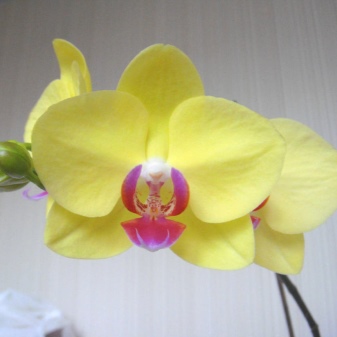
- A representative of the phalaenopsis with bright yellow flowers of medium size is considered to be Stewartin. It is distinguished by the originality and unusual shape of both the flowers themselves and the peduncle as a whole. One stem can have up to 50 medium-sized flowers. All of them have a rich shade of yellow and are complemented by a variegated core with red dots on it.
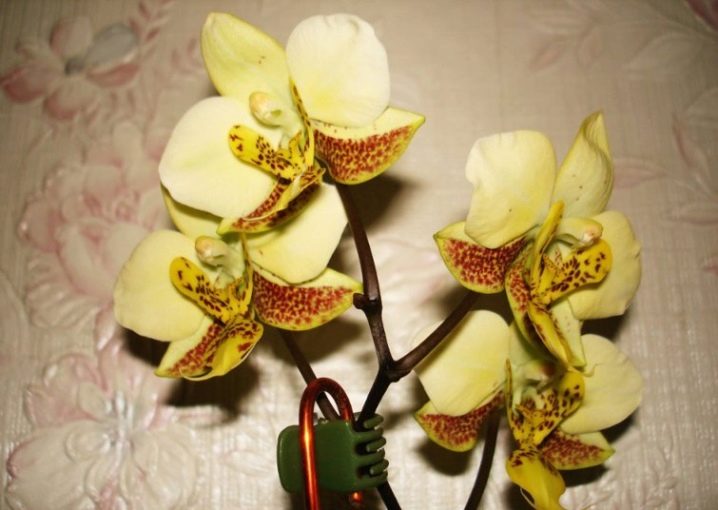
- Varieties "Midi", "Melodies", "Mini Mark" belong to the group of small-growing plants. Such orchids, together with leaves and flowers, grow no more than 20-25 cm. They bloom for a long time, and require the most usual care.

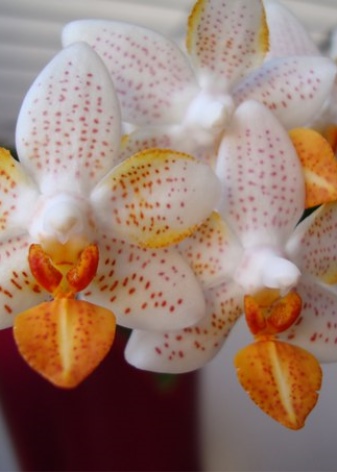
- The variety of orchid species has been increased due to hybrids. One of them is Multiflora. Unlike a standard plant, her peduncle grows to the sides, in the form of branches. The result is a lush cap of airy and delicate flowers. An adult orchid is replete with pink, white, peach and rich yellow shades. Her petals are dense to the touch.
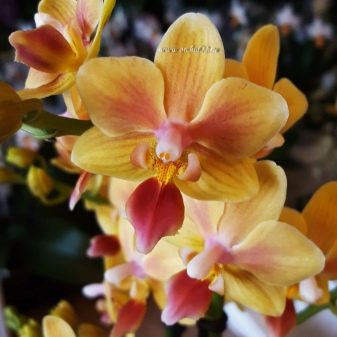
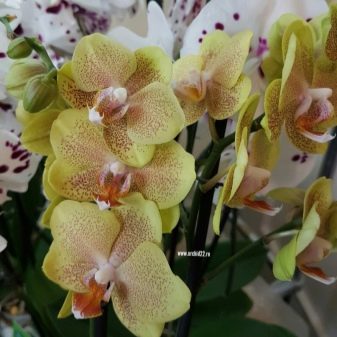
- Phalaenopsis mutants include "Peloric". This beautiful plant gets its name from the flower shape, which differs from the standard sample. His horizontal petals merge at the ends and form a triangle. As a result, the flowers look completely asymmetrical and unusual. Orchid "Peloric" is not exclusively yellow, it is diluted with pink or red shades that are present on the flower itself in the form of peculiar streaks or dots.
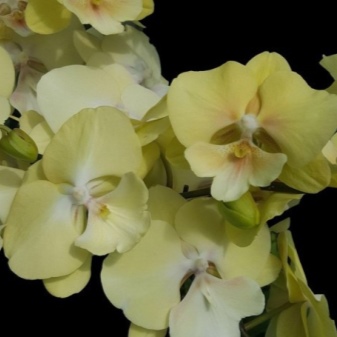
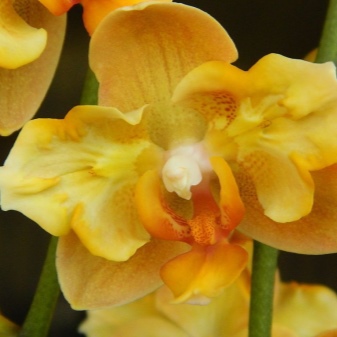
Yellow orchids have a different aroma in saturation. There are types of very nice-smelling flowers that resemble the smell of lilies of the valley. These include, for example, Sogo David. Its aroma becomes intense in the morning and evening hours. On sale, it is not so common.
Happy buyers will have the opportunity to enjoy the sight and scent of this beautiful plant for years, if they manage to get it.
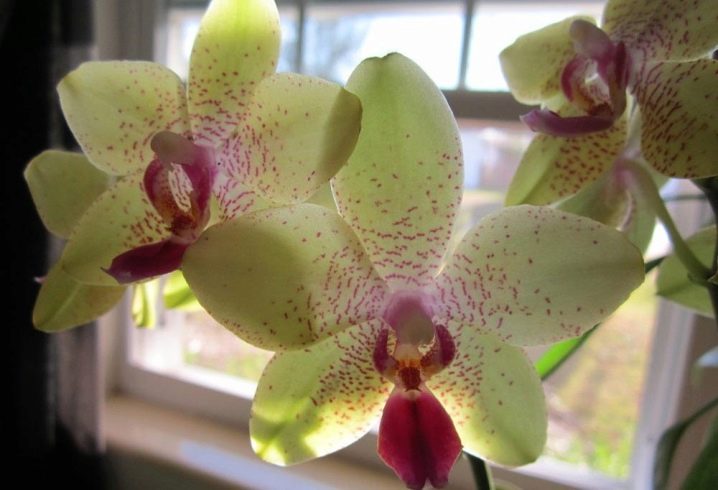
Transfer
A flower purchased from a store needs to be transplanted into a pot. There are other reasons, which include: plant diseases, a highly overgrown root system, or force majeure when your flower accidentally fell and fell out of the pot.
In each of the cases, except for the last, this procedure should be carried out when the flowering period is over. If you decide to transplant the plant at this time, then there is a possibility that it will wither away, since such a process will be a real stress for a flowering phalaenopsis. According to the general rule of caring for orchids, they must be transplanted once every three years.
It is best to transplant a flower in the spring or autumn. After transplanting, the orchid should be placed in a well-lit place to ensure the penetration of sunlight to the root aerial part.
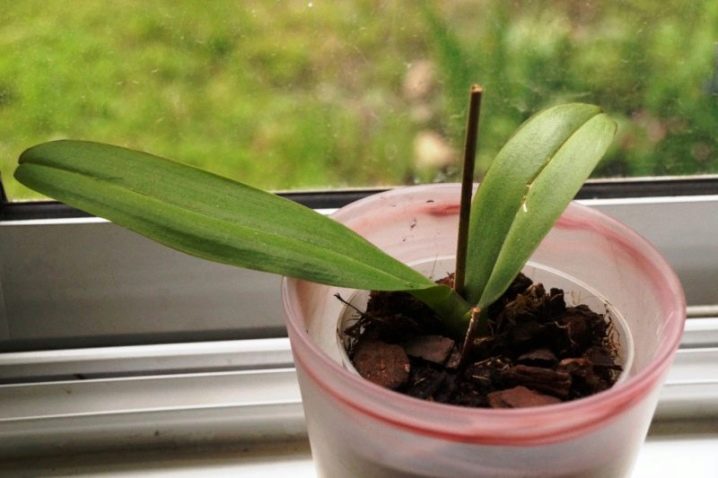
All orchid transplant work consists of several stages.
- The plant is removed from the old pot. The roots are washed, freeing them from the old soil.
- Cleanses roots from dry and rotten parts. Remove any yellowed leaves.
- The flower is dried for 1-2 hours.
- They land on a new place (in a pot).
The speed of adaptation of your flower to a new place will depend on how correctly you choose the time for the work.
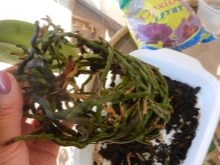

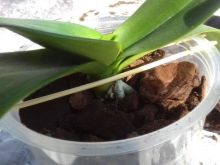
Subtleties of care
The planting is carried out in a transparent pot. The substrate is chosen for a given flower so that it can retain moisture for a long time - this will allow the roots of the flower to breathe. You can also prepare the composition at home, this will require:
- pine bark;
- charcoal and sphagnum peat.

Phalaenopsis is adapted for flowering in city apartments. As for lighting, then the flower can be grown even under artificial light conditions.
The most favorable place for the growth and development of an orchid will be a window sill with an exit not to the sunny side of the home. In the hot summer period, bright sunlight can cause burns to the plant, as a result of which brown spots appear on the leaves. When caring for phalaenopsis, a number of rules should be considered:
- watering the flower correctly;
- observe the appearance and timely remove wilted flowers and leaves;
- feed at the right time;
- transplant the plant.
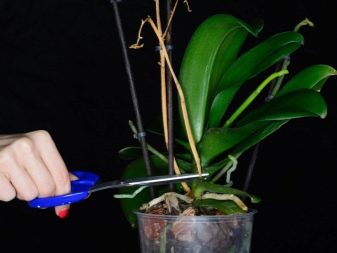

After the orchid has faded, you can prune, but only if there are no new buds on the peduncle. If they appear, then you do not need to touch the plant. In the case of "falling asleep" buds, the peduncle is trimmed above them at a height of 80 mm or 1 cm, and a bandage with moss is fixed around the bud itself. After that, the flower is placed on a pallet with sand.
Watering
This procedure is performed once or twice a week. Water the plant after the moisture on the surface of the soil has evaporated. Before flowering, during the growth period, a kind of irrigation of yellow phalaenopsis is carried out. This process contributes to the active growth of the root system of the orchid.Healthy plant roots are green in color, and their change to a silvery shade indicates a lack of moisture. The situation can be corrected by placing a flower pot in water for two hours.
The excess moisture when the roots start to rot is expressed in the brown color of the roots. In this case, the plant should not be watered for a while, it should only be sprayed in very hot weather.

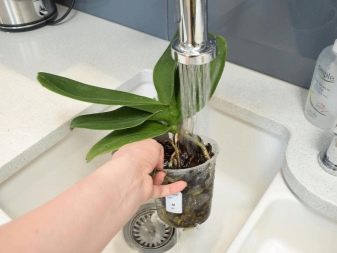
Top dressing
Fertilize phalaenopsis, preferably with tree bark and moss. This dressing is sold in flower shops. When the plant is actively growing and developing, then it is necessary to apply fertilizer along with water for irrigation. Orchids are often fed with a weak urea solution to stimulate plant growth. The composition is introduced by spraying.
Fertilization with superphosphate or mullein is carried out in order to form flower buds. There are a number of granular formulations that have the necessary elements for plant nutrition. The orchid can also be fed with fertilizers intended for citrus plant species. If you do not have proper experience in the application of certain fertilizers, it is best to buy liquid substances from a flower shop that are exclusively for orchids.
Any flower feeding should be carried out in the spring and until mid-summer. After this period, it is not recommended to fertilize phalaenopsis. Plant growth stops by the onset of autumn.
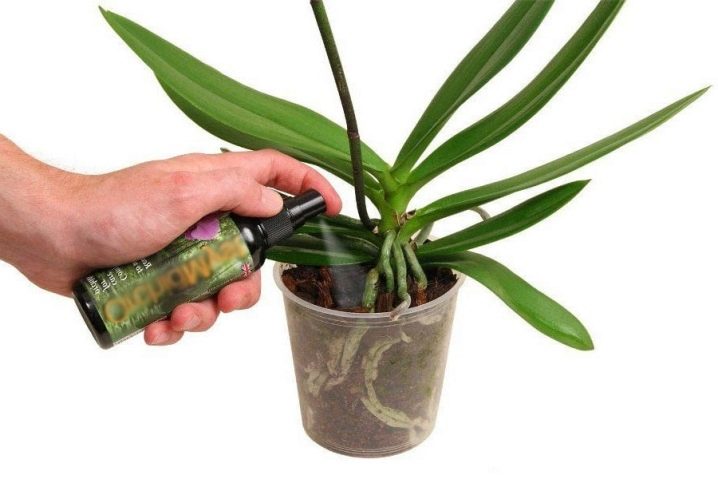
Reproduction
You can perform the process of propagating an orchid at home using sterile tools. There are several ways, which we will dwell on in more detail.
- When your flower has faded, then the entire peduncle needs to be cut off, which is called at the root. The arrow (stem) is cut into cuttings of equal size within 4 cm each. Moreover, they must contain a kidney that is asleep. Then, the cut points are carefully processed with activated carbon and all the cuttings are placed in a miniature greenhouse containing moist moss. They are there until germination. The greenhouse maintains high air humidity and temperatures up to 28 degrees Celsius.
- Yellow phalaenopsis with a large rosette and a large number of leaves are propagated by dividing the rosette itself into parts. Cut off the top of the orchid with some leaves and the presence of aerial roots. Places of cuts are treated with charcoal. The cut stalk is transplanted into the pot separately. The main mother plant, after cutting from it, is also treated with charcoal. After a while, buds appear at its base on the sides, from which new orchids are subsequently formed. After the "children" grow up, they are planted in separate pots containing pine bark and sphagnum moss as soil.
- After the phalaenopsis has faded, you can cut the peduncle. Then it is placed in the sun in water with fertilizers. The air temperature should be at least 27-28 degrees. After a certain time, the activation of all dormant buds begins, from which the "children" of the orchid sprout. They develop until air roots and one or two leaves appear. Then you can separate the new formations from the main flower and transplant into separate containers.
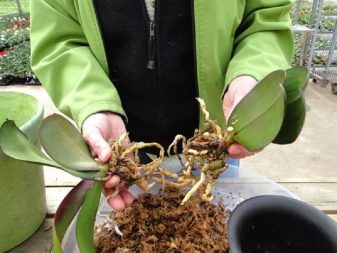

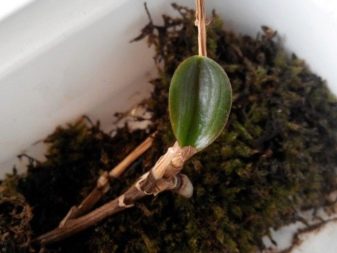

Diseases and pests
The orchid is a rather resistant plant to diseases and pests, but unlike other flowers, it has a number of diseases that affect both the root system and the leaves. She has fungal and viral diseases. If the plant has undergone fungal diseases, then there is a chance to cure it completely. When it is affected by viral infections, it is better to destroy such an orchid in order to avoid infecting other indoor plants.
The most common diseases include:
- root and gray rot;
- leaf spot, fusarium rot;
- anthracnose and powdery mildew.
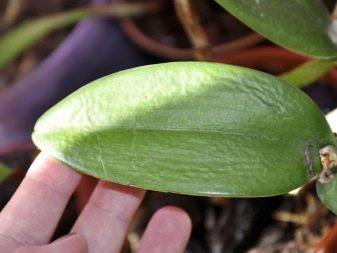
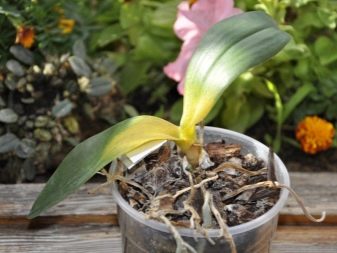
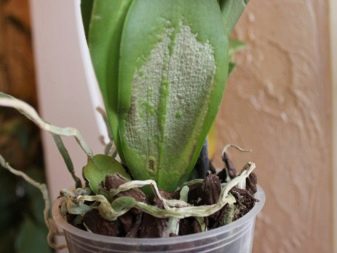
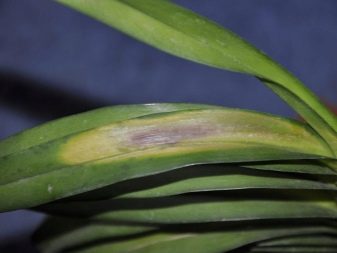
They are treated with drugs such as Fungicide, Fundazol, Topsin.
The flower is also affected by pests: bugs, aphids, scale insects, thrips, spider mites, mealybugs, nematodes. Preparations actively fight against them: Fitoverm, Chlorofos, Aktellik, Dekaris, Levomizal.
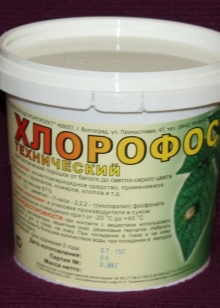
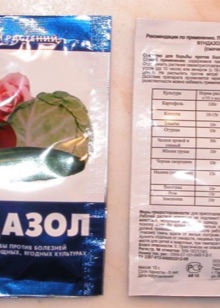
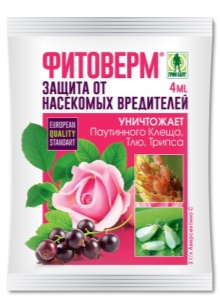
If you take care of the orchid, it will delight you with its unique yellow flowers and pleasant aroma for a long time.
For the care of a yellow orchid and the features of its transplant, see below.































The comment was sent successfully.